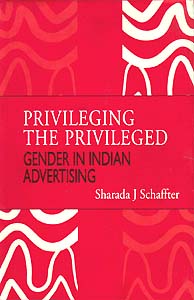My sincere thanks to cricket, news channels, soaps, the fashion industry and Bollywood for providing me with my daily laughs. If not for you, I would still be writing dull brochure copy.
Sunday, April 23, 2006
No woman no cry
Sharada J Schaffter delves into a world of perceived imagery, implied meaning and stereotyped roleplays in society - that of a dominant male and an exploited female.
Don’t depict women as homemakers – you are demeaning their capabilities. Don’t portray them as pretty pictures – you are insulting their intelligence. Don’t show them as professionals in the service industry– they are capable of other careers as well. Don’t not show them in ads – why are you ignoring them? Schaffter puts the advertising industry into a damned-if-you-do, damned-if-you-don’t quandary in her book ‘Privileging the Privileged – Gender in Indian advertising’.
While there is certainly a serious concern about the way women are projected in advertising, Schaffter takes things a bit too far when she objects to a girl’s cycle being called Cinderella because the name is connected to a tale where ‘a young man has to redeem a young woman’. Allen Solly can’t talk about Friday dressing because it looks like ‘de-stressing on a Friday is made out to be a male domain’. A woman embracing the Raymond’s man is indicative of the fact that she becomes a ‘bonus on purchase of the product’. But what takes the cake is a comment on an ad’s visual - ‘The gutter binding of the magazine is made to fall in the cleft between her thighs.’ (Imagine advertising and media professionals sitting with a client and planning THIS one out!)
Deciphering advertising through the discipline of semiotics, Schaffter reveals hidden meanings and some shocking interpretations of advertising and in the process, uncovers a hidden order that operates with the sole objective of making women a ‘bed and breakfast’ commodity. For those of you who have read the Da Vinci Code, think of this as an extension - the Ad Vinci Code.
The book begins with an arduous journey through tradition-oriented orthodoxy, male monopoly, sati, caste system, violence, rape, sexual harassment, poverty, literacy, illnesses, dowry harassment and corruption as Schaffter builds a case for the downtrodden Indian woman. But unfortunately, all of it is crunched in one chapter – the Indian background - that is meant to set the stage for the ultimate assault on a male dominated industry. Unfortunate because, when there are such serious issues that remain to be tackled, who gives a damn if a woman is shown behind the man (indicating lesser importance), her hand on his shoulder (dependence), her right knee bent at a slight angle (a sign of weakness), her right hand partially covering her smiling mouth (a gesture of embarrassment and shyness)?
The book also indulges in a bit of India bashing, with subheads like ‘India - underdeveloped, corrupt and mostly rural’. Adam & Eve, Mahabharat, Ramayana, Manu, Genesis - not even the Industrial revolution is spared to help establish how men have methodically plotted their way to keep women in the background. Even festivals like raksha bandhan are used to point out a girl’s dependency on a man (her brother) to protect her. In her mission to highlight the plight of women, Schaffter punctuates the book with words like domination and exploitation. ‘Demanding, controlling, aggressive, dominant and sometimes criminal’ is man. Sex object, marketable commodity, a creature fashioned by man for man – that’s woman.
Schaffter also proposes advertising codes to help ensure fair portrayal of women. This also includes guidelines for non-sexist language, with a table of ‘offensive phrases’ and their less sexist alternatives. While it may do wonders for women, be prepared to wave goodbye to your favourite women icons from the Hall of Femme – Lalitaji (only a homemaker), the Singapore Girl (What? Service industry?), the Cadbury’s girl (why can’t she hit a six and her boyfriend do a jig?) and the Amul girl (why are girls shown only with kitchen products?). They’re mere stereotypes, remember?
(Appeared in the New Indian Express Sunday Supplement on 02 April, 2006)
Subscribe to:
Post Comments (Atom)

No comments:
Post a Comment